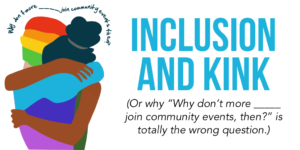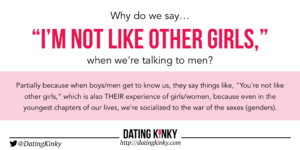One day, I ran across this interesting Five Point Scale For Bottoms post (the link is dead now, so look below), and while I know that it is too simplistic to cover everything, AND I eschew labels as a be-all-end-all, I also thing it’s a very cool idea and way to communicate a preference/concept quickly and effectively.
1. Fetish top: “Worship my boots and shine them brightly.”
Fetish tops differ from other types of fetishists in that the object/activity they eroticise is associated with a bottom. In their purest form, they have little need to interact with the bottom or dominate others in real life encounters.
2. Sadist top: “I’d love to whip you until you safeword.”
Sadists take things a bit further, and look for bottoms that will allow them to subject their subjects to pain, humiliation, and possibly physical control, such as bondage. The dynamic of the scenes is still one of equality, and it is clear that everything is done for mutual gratification, and ends where the scene does.
3. Roleplay dominant: “I’ll be the professor, and you be my student…”
This involves assuming roles for a temporary scene (from a few hours up to a few days) which would normally be associated with inequality and with one person having power or authority over the other: for example, a store detective blackmailing a shoplifter into obeying him. However, it is understood that the goal of the scene is direct mutual satisfaction for both top and bottom (eg, that the “shoplifter’s” desire to be held down, “ravished” and sworn at is catered to.)
4. Lifestyle dominant: “Here’s how I want things done.”
This can sometimes be difficult to distinguish from a long term relationship involving roleplay dominance. However, the essential feature of a lifestyle dominant is their desire to enjoy service over time, in an ongoing relationship. The dominant accepts service with ongoing expectations (negotiated) of timing and quality, for as long as the relationship remains, or until terms are renegotiated.
5. Master: “I will make your life decisions for you.”
A Master differs from other types of tops in that they take full ownership of the slave bottom, making decisions not only on submission and the relationship, but on their lives in total. The only decision not within the Master’s purview is whether the slave chooses to end the relationship. Therefore, the Master is defined by their relationship with their slave: “Ownership rather than obedience is the defining quality of slavery; obedience rather than ownership is the defining quality of submission.”
For myself, within these labels, I’d sit solidly within 4. That’s who I am, as other kinds of topping are all about finding the sweet spot to inspire greater submission and furtherance of the relationship itself.
What are your thoughts?
Where do you fall as a top or as a bottom on these scales? Do you find them useful at all?
I think they are quite useful, and use them in discussions with others, to understand them better. Not because other (and more words) won’t work, but because this gives a mutual starting point to discuss in further detail.
Five Point Scale for Bottoms
The original link is dead, so here it is:
This is a scale of how much authority over the “bottom” is acquired by the “top”. It is an attempt to describe a system of terms which will be useful in discussing the various phenomena associated with SM, D/s and M/s.
In itself, this ordering is not intended as a value judgement. However, many people implicitly place higher value on more intense activities and so something similar to this list is lurking in the subconscious of many BDSM subcultures. This gives rise to two widespread causes of antagonism: people looking up the scale with a “even if you’re a submissive (or slave), you’re no better than us masochists (or submissives)” agenda; and people looking down with a “stop pretending you’re really a submissive (or slave), you’re just a masochist (or a submissive)” attitude. It is not unusual for the resulting arguments to hinge on the word “genuine”, as one group is not the genuine article according to the definition of the other.
My opinion is that most SM vs D/s vs M/s arguments are caused by the belief that everyone should call themselves whatever they like, and that common definitions are inappropriate. My belief is that meaningful communication is impossible without commonly held definitions.
1. Fetish bottom: “I worship your boots and want to serve them.”
Fetish bottoms differ from other types of fetishist in that the object they eroticise is associated with a top. They are almost invariably male, and in the pure form have little need to interact with the top or to submit their will in real life encounters.
2. Masochist: “I want you to use the needles tonight.”
Masochists take things a step further and grant the top authority to subject them to pain or humiliation, or perhaps to physical control such as bondage. However, the dynamic of these scenes is still one of equality, and it is clear that everything is done for mutual gratification.
3. Roleplay submissive: “Can I be the Girl-Caught-Shoplifting tonight?”
This involves assuming roles for a temporary scene (from a few hours up to a few days) which would normally be associated with inequality and with one person having power or authority over the other: for example, a store detective blackmailing a shoplifter into obeying him. However, it is understood that the goal of the scene is direct mutual satisfaction for both top and bottom (eg, that the “shoplifter’s” desire to be held down, “ravished” and sworn at is catered to.)
4. Servant: “What can I do for you now, Sir?”
This can sometimes be difficult to distinguish from a long term relationship involving roleplay submission. However, the essential feature of a servant or service orientated submissive / bottom is their desire to do things purely for their top’s benefit (literally, to serve.) Hence, a servant may derive great satisfaction from doing housework at the top’s home. Nevertheless, this kind of service is voluntary and is an example of “ongoing voluntary submission”. The bottom constantly chooses to stay and to serve, even if that choice is just implicit in their continued presence and obedience.
5. Slave: “You have the authority to decide things for me, Master.”
A slave differs from other types of bottom in that they have no (enforceable) rights with respect to the top. In particular, they cannot remove themselves from the relationship, and cannot themselves chose to impose restrictions on what is done to them. This lack of rights in the face of the top’s acknowledged authority over them constitutes ownership. The difference between a servant and a slave can be summarised by: “Ownership rather than obedience is the defining quality of slavery; obedience rather than ownership is the defining quality of submission.” –>
There are two further subdivisions:5a External Enslavement – in which slavery is enforced by external forces, such as threats to hunt slaves down and retake possession of them if they run away. This approach has limited plausibility in a modern society, at least for any length of time.
5b Internal Enslavement – in which slavery is acheived by forging an emotional bond which the slave cannot extricate themselves from. This approach is ultimately dependent on the validity of the Internal Enslavement Hypothesis (in short, that submissives with such a great need to be owned exist, and that a Master can create a psychological environment in which that need comes to the fore.)








